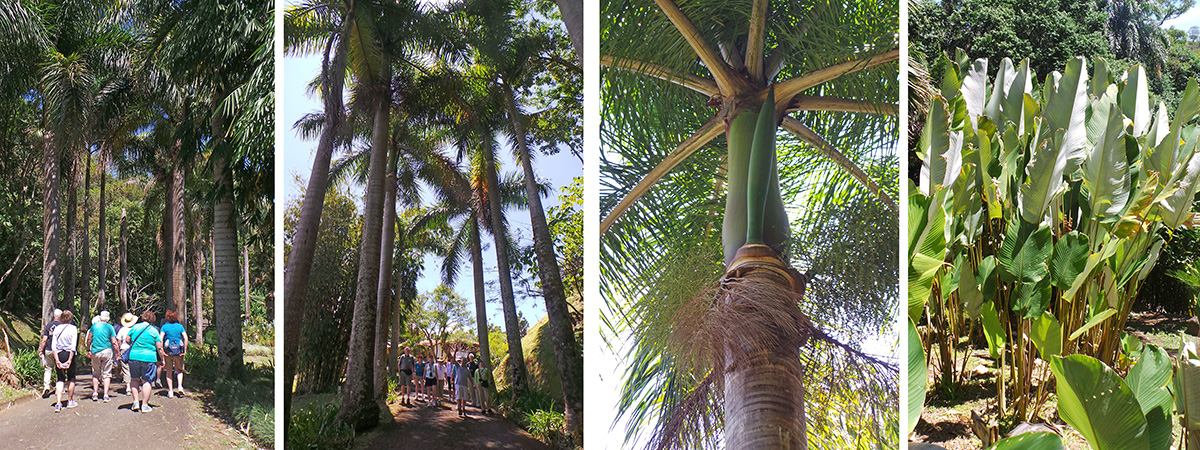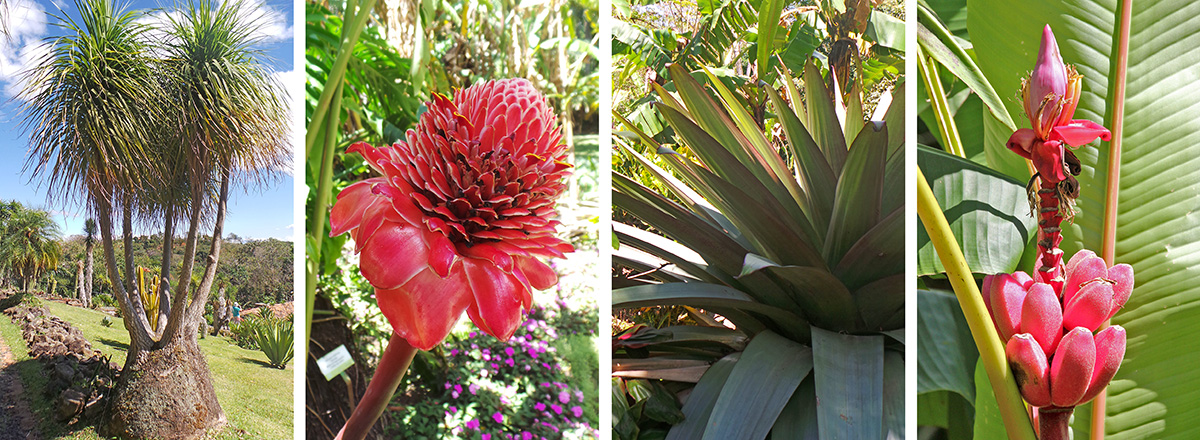This morning we returned on the ferry and drove back to the Central Valley. By noon we had arrived at Jardín Botáníco Else Kientzler in the town of Sarchi. After eating a catered lunch out on the verandah of the reception building, our guide Mauricio told us the history of the gardens. It was created about 10 years ago by the German company InnovaPlant from a former coffee plantation in memory of the company owner’s mother. The 7 acres have been landscaped and planted with tropical ornamental landscape plants from around the world, and is the fifth largest botanical garden in Costa Rica. InnovaPlant produces primarily unrooted cuttings of ornamentals for export to the US.

Mauricio tells the group about the Garden (L), overlooking the gardens from the reception area (C), the maze (R).
After answering a few questions, Mauricio took us on a tour of the garden, stopping periodically to tell us about some of the various plants we encountered. We walked a short way down the road lined with towering Cuban royal palms (Roystonea regia) that were about 40 feet tall after only 10 years. We learned about the native Calathea lutea that grows throughout the country, with the underside of the leaves a silvery color that helps reflect sunlight to reduce moisture loss and the rattle snake rattle-like inflorescences.

The group heads down the road (L) under the Cuban royal palms (LC); royal palm crown and flower bud (RC); Calathea lutea (R).
Many of the other plants he talked about were interesting ornamental plants from other parts of the world, such as sago palm and ponytail palm (both of which are not true palms), the huge terrestrial bromeliad Alcantarea (= Vresia) imperialis, torch ginger, and ornamental bananas.

Ponytail palm (L), torch ginger flower (LC), terrestrial bromeliad Alcantarea (= Vresia) imperialis (RC) and ornamental bananas (R).
Petunias, salvia, impatiens and cleome were planted in masses here and there . There is a bit of native forest down by a stream, but we didn’t go on that trail. We did see a number of Costa Rican natives, such as the big Ceiba pentandra tree and guavas (Psidium guajava) with their smooth, mottled bark, the palm Chamaedorea costaricana that we had seen in the Monteverde Cloud Forest Preserve with Willow, the bright red flowers of Passiflora coccinea, and Monstera deliciosa.

Looking up the Ceiba pentandra tree (L), guava (Psidium guajava) (LC), Chamaedorea costaricana (C), Passiflora coccinea (RC) and Monstera deliciosa fruit (R).
We looped around to take the forest path high on the ridge that ends at the succulent garden on the hill above the reception building. It has a smattering of succulent plants from around the world, but not many were labelled, and no one was really interested in standing around in the broiling sun to look at them.

The succulent garden (L), an agave (LC), Euphorbia stenoclada from Madagascar (RC), African aloe in bloom (R).
Many families were at the Garden having a picnic, and from their perspective this is a serene spot to enjoy the attractive landscaping with colorful flowers and lush foliage rather than a place to learn about plants.

Picnickers in the garden (L), flower of Heliconia rostrata (LC), closeup of bromeliad inflorescence (C), inflorescence of Brazilian red cloak (Megaskepasma erythrochlamys) (RC), and planting of many colors of annual salvias (R).
After visiting the Garden we went to Fabrica de Carretas Eloy Alfaro in Sarchi for a quick shopping opportunity. We first went into the back courtyard where Gustavo explained the evolution of the oxcart wheel and the fancy decorations on the carts.

Gustavo tells the group about how wooden oxcart wheels are made (L), historic wagon wheels (LC), historic painted wagon wheels (RC), modern decorations on wooden wheel (R).
Then we watched artists painting. One offered to let us try our hand at painting, so Susan took the brush and applied a few strokes to a piece in progress – without ruining it, although the artist did fix it up a bit afterward. Of course he has 43 years of experience, whereas Susan only has 43 seconds of experience! Then we had time to shop for colorful painted items or other souvenirs in the extensive showroom before heading back to the Hotel Bougainvillea in the big city.

Artist painting a cart (L), colorful paints (LC), souvenirs for sale (RC), Jim, Cindy and Becky relax in the chairs outside the shop (R).
